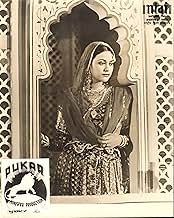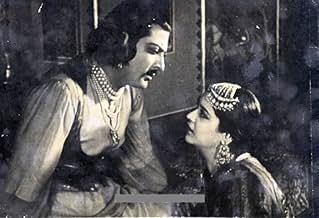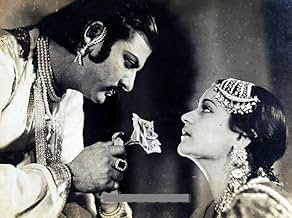Ajouter une intrigue dans votre langueA love affair and two feuding families who play out a Romeo and Juliet type drama in 17th century India, under the Emperor Jehangir.A love affair and two feuding families who play out a Romeo and Juliet type drama in 17th century India, under the Emperor Jehangir.A love affair and two feuding families who play out a Romeo and Juliet type drama in 17th century India, under the Emperor Jehangir.
Histoire
Commentaire en vedette
Pukaar (1939) is a period movie which shows the reign of the Mughal emperor - Jahaangir who was famous for his true and unbiased justice. A huge bell (Ghanta) used to hang at his palace whose pulling chain used to keep on hanging at the door of the palace and any aggrieved person could ring that bell by pulling that cord to make the emperor aware that somebody is seeking justice from him. It was famous as the 'Chain of Justice'. Pukar is based on an anecdote linked to this system only in which Jahangir had declared that KHOON KA BADLA KHOON YAHI JAHAANGIR KA NYAY HAI (an eye for an eye is the correct justice in the view of Jahaangir).
The story starts with the love story of Mangal Singh (Saadiq Ali) and Kanwar (Sheela). Mangal Singh is the son of a trusted Rajput chieftain of the Mughal emperor Jahaangir - Sangraam Singh (Sohraab Modi). Since the family members of Kanwar are against her marriage with Mangal Singh, a bloody fight takes place in which the father and the brother of Kanwar are killed in the hands of Mangal Singh. Now Mangal Singh is a criminal in the eyes of the law and Sangraam Singh being completely loyal to the state, arrests him and hands him over to the authorities. Death penalty is awarded to Mangal Singh for the murders committed by him. Sangraam Singh being a loving father, appeals to the emperor Jahaangir (Chandra Mohan) to award amnesty to his son but his request is turned down by the emperor on the plea that Jahangir's justice means blood for blood (or a life for a life). Sangraam Singh is left with no choice but to accept his verdict and return to his own with a grief-laden heart.
However an unexpected incident creates a twist in this flat tale. Empress Noor Jehan (Naseem Baanu) inadvertently kills a washerman by her arrow while practicing archery. Now Sangraam Singh sees an opportunity in this incident to save the life of his son. He takes the aggrieved widow of that washerman to the palace and makes a call to the justice of the emperor through her. He demands that if an eye for an eye (or blood for blood or a life for a life) is the emperor's justice then it should be applicable to all irrespective of the concerned's status. The penalty awarded to his son should be awarded in this case also without any discrimination being made due to the status of the culprit (i.e., the empress). What happens thereafter forms one of the most memorable sequences of the history of Bollywood cinema, culminating in a great finale.
Pukaar is a great movie by all standards, a true classic, a masterpiece. None in Bollywood could match the skills of Sohraab Modi in making impressive period movies or costume dramas (with the sole exception of K. Asif). This master moviemaker has made this movie with such a zeal and sincerity that every scene has its moments, every frame has its beauty. I had seen this movie long back on Doordarshan but its impact was so great that even after years, I am able to recall the scenes and the dialogues and feel the tone of the movie.
It's a costume drama whose period goes back to the seventeenth century A.D. Hence Sohraab Modi had paid special attention to the costumes, the sets and above all, the dialect spoken by the characters. Everything is realistic and reliable. The Urdu laced dialogues are simply great. The screenplay has been written so impressively that the impact of the movie thickens and thickens with the passage of succeeding scenes. The cinematographer in association with the art director and the costume designer has infused life into the movie and enlivened that period on the screen.
The background score is perfectly in sync with the mood of the movie. Mir Saheb has composed melodious tunes for the lyrics penned by the script-writer, Kamaal Amrohi (who later became a great filmmaker in his own right). All the songs are good but considering that time of the thirties, the listener has to listen to them with a particular mindset and appreciate the quality of the lyrics too. The best song, in my opinion, is - Zindagi Ka Saaz Bhi Kya Saaz Hai which is a duet sung by the music composer - Mir Saheb and the lead actress - Naseem Baanu.
Finally, it's the performances which is the brightest aspect of this brilliant period movie. Sohraab Modi himself alongwith Saadiq Ali, Sheela, Naseem Baanu (who happens to be the mother of the highly successful Bollywood heroine, Saaira Baanu) and others have performed to perfection. Though the performances and dialogue delivery are a bit theatrical but this fact is to be seen and felt in the light of the time in which the movie was made, the period to which the story belongs to and the nature of the narrative. The tallest performance has been delivered by Chandra Mohan as the emperor Jahaangir. This role and especially his performance in the climax scene has immortalized him in the history of Bollywood cinema. It's a performance that no spectator can ever forget. His dialogue delivery when repeating - TAMEEL HO (my order should be executed) alongwith the feeling expressed through his eyes can be counted as one of the greatest acting performances ever seen.
This more than seven decades old movie can be enjoyed by today's generations and the young generation will come to know by watching it that such superior quality movies used to be made in that period too when technology development had not even taken off, when resources were limited and when naturalness in acting was yet to emerge. Pukar was a blockbuster movie in its time and the reason behind its being a blockbuster can be easily understood by watching it on the small screen today.
The story starts with the love story of Mangal Singh (Saadiq Ali) and Kanwar (Sheela). Mangal Singh is the son of a trusted Rajput chieftain of the Mughal emperor Jahaangir - Sangraam Singh (Sohraab Modi). Since the family members of Kanwar are against her marriage with Mangal Singh, a bloody fight takes place in which the father and the brother of Kanwar are killed in the hands of Mangal Singh. Now Mangal Singh is a criminal in the eyes of the law and Sangraam Singh being completely loyal to the state, arrests him and hands him over to the authorities. Death penalty is awarded to Mangal Singh for the murders committed by him. Sangraam Singh being a loving father, appeals to the emperor Jahaangir (Chandra Mohan) to award amnesty to his son but his request is turned down by the emperor on the plea that Jahangir's justice means blood for blood (or a life for a life). Sangraam Singh is left with no choice but to accept his verdict and return to his own with a grief-laden heart.
However an unexpected incident creates a twist in this flat tale. Empress Noor Jehan (Naseem Baanu) inadvertently kills a washerman by her arrow while practicing archery. Now Sangraam Singh sees an opportunity in this incident to save the life of his son. He takes the aggrieved widow of that washerman to the palace and makes a call to the justice of the emperor through her. He demands that if an eye for an eye (or blood for blood or a life for a life) is the emperor's justice then it should be applicable to all irrespective of the concerned's status. The penalty awarded to his son should be awarded in this case also without any discrimination being made due to the status of the culprit (i.e., the empress). What happens thereafter forms one of the most memorable sequences of the history of Bollywood cinema, culminating in a great finale.
Pukaar is a great movie by all standards, a true classic, a masterpiece. None in Bollywood could match the skills of Sohraab Modi in making impressive period movies or costume dramas (with the sole exception of K. Asif). This master moviemaker has made this movie with such a zeal and sincerity that every scene has its moments, every frame has its beauty. I had seen this movie long back on Doordarshan but its impact was so great that even after years, I am able to recall the scenes and the dialogues and feel the tone of the movie.
It's a costume drama whose period goes back to the seventeenth century A.D. Hence Sohraab Modi had paid special attention to the costumes, the sets and above all, the dialect spoken by the characters. Everything is realistic and reliable. The Urdu laced dialogues are simply great. The screenplay has been written so impressively that the impact of the movie thickens and thickens with the passage of succeeding scenes. The cinematographer in association with the art director and the costume designer has infused life into the movie and enlivened that period on the screen.
The background score is perfectly in sync with the mood of the movie. Mir Saheb has composed melodious tunes for the lyrics penned by the script-writer, Kamaal Amrohi (who later became a great filmmaker in his own right). All the songs are good but considering that time of the thirties, the listener has to listen to them with a particular mindset and appreciate the quality of the lyrics too. The best song, in my opinion, is - Zindagi Ka Saaz Bhi Kya Saaz Hai which is a duet sung by the music composer - Mir Saheb and the lead actress - Naseem Baanu.
Finally, it's the performances which is the brightest aspect of this brilliant period movie. Sohraab Modi himself alongwith Saadiq Ali, Sheela, Naseem Baanu (who happens to be the mother of the highly successful Bollywood heroine, Saaira Baanu) and others have performed to perfection. Though the performances and dialogue delivery are a bit theatrical but this fact is to be seen and felt in the light of the time in which the movie was made, the period to which the story belongs to and the nature of the narrative. The tallest performance has been delivered by Chandra Mohan as the emperor Jahaangir. This role and especially his performance in the climax scene has immortalized him in the history of Bollywood cinema. It's a performance that no spectator can ever forget. His dialogue delivery when repeating - TAMEEL HO (my order should be executed) alongwith the feeling expressed through his eyes can be counted as one of the greatest acting performances ever seen.
This more than seven decades old movie can be enjoyed by today's generations and the young generation will come to know by watching it that such superior quality movies used to be made in that period too when technology development had not even taken off, when resources were limited and when naturalness in acting was yet to emerge. Pukar was a blockbuster movie in its time and the reason behind its being a blockbuster can be easily understood by watching it on the small screen today.
- jmathur_swayamprabha
- 11 mai 2012
- Lien permanent
Meilleurs choix
Connectez-vous pour évaluer et surveiller les recommandations personnalisées
Détails
- Durée2 heures 45 minutes
- Couleur
- Mixage
- Rapport de forme
- 1.37 : 1
Contribuer à cette page
Suggérer une modification ou ajouter du contenu manquant










